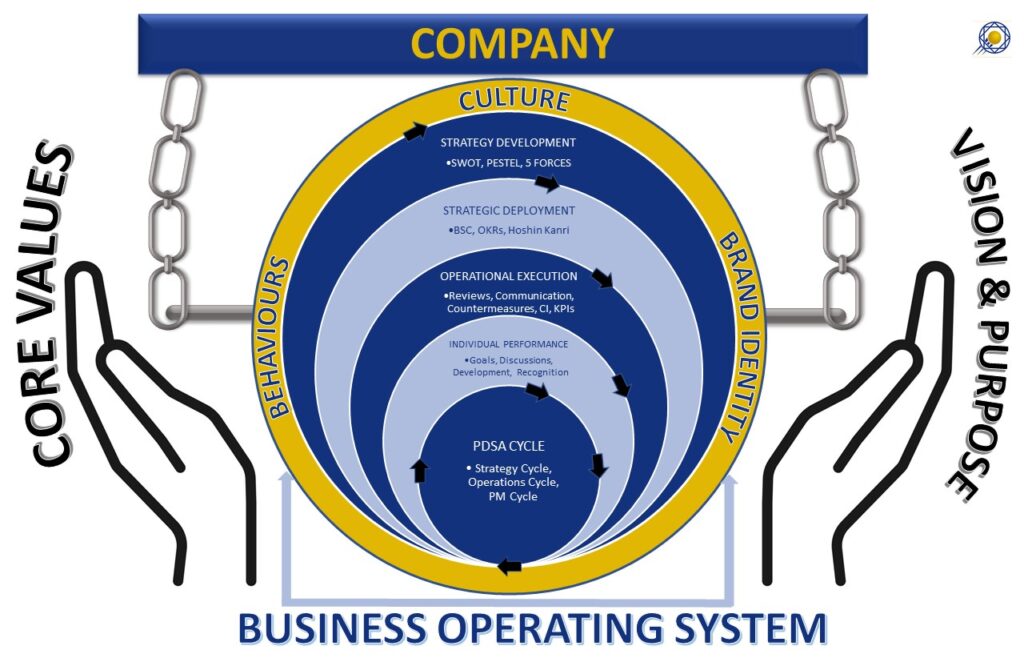
As the final installment in the series, it’s time to bring everything I’ve written together to provide a cohesive framework that supports your business.
We’ve discussed some key elements to bring a company’s vision to life. Strategy development, deployment, and execution. Change management and communication tools. Individual performance management. Scattered throughout the posts have been references to various types of continuous improvement tools.
I’m not about to suggest this is all it takes to allow a company to grow and be successful. I haven’t touched much upon culture and behaviours, leadership, sales and the customer, or all of the hard skills (financial acumen, product design and development, project management) and day-to-day performance (the hand-to-hand combat) needed for success.
What I have hopefully painted is what a Business Operating System (BOS) looks like. I’ve been fortunate to experience some very mature and successful ones over my career: TPS (Toyota), DBS (Danaher), HOS (Honeywell), ACE (UTC), and EBS (Eaton), to name a few. I have come to adjust my thinking on many of these. In the last few decades, most Business Systems have been closely associated with continuous improvement, Lean, Six Sigma, or other improvement methods. That isn’t what makes a BOS. Those are tools for adding value, waste elimination, or process reliability. They are usually most prevalent inside the Operational Execution cycle of a business. They shouldn’t define how an organization works.
No, a solid and flexible BOS should provide a framework and set of person-independent processes to structure how leadership guides, develops and manages the business. It operates at a level below the company’s vision and purpose, as well as its core values. Those were likely established at the company’s inception, if not soon after, and shouldn’t change. If those are a company’s brain (vision) and heart (core values), then the BOS connects the dots; it’s the nervous, skeletal, cardiovascular, and muscular systems. It ensures that every part of the body (organization) is connected, understands its role, and knows what to do to perform effectively.
Similarly, a BOS works at a level above most task-specific elements of a business. In the diagram above, the size of the Operational Execution cycle is somewhat over-simplified. There is a great deal of depth, complexity, and detail that goes into the company’s actual performance. It is meant to capture both the execution of the strategy and ensure existing performance is sustained or elevated. Ensuring that SOPs and WIs are in place for processes is assumed, as are standard Quality, Finance, H&S, and HR processes. A BOS, through a PDSA cycle, might identify something that can be improved, but it would typically assume foundational processes already exist. That’s partly because, at the initial phase of a new company, much of what I’ve shared is overkill. It’s a 1 or 2-person show. They know everything that’s going on. As the company grows, it’s natural for more of these elements to take hold. Often, an integrated, chain-linked BOS is one of the last vital components to be added.
At the core of each cycle shown? A simple plan-do-study-act cycle. In the (em)Powering Performance article, I wrote that a Performance Management cycle is similar to what Dr. Deming and Walter Shewhart envisioned for their PDSA learning and improvement cycle. In many cases, this is a natural approach that we’ve come to use in working through various problems. Understand the challenge, plan some actions, implement them, observe the responses and outcomes, and adjust if required. Almost any type of problem-solving or improvement process would do well to follow these steps. The diagram shows it must be a part of every business process, either at the company level or the individual. Sometimes, the “P” and “S” steps are ignored, which can result in endless firefighting.
My last thought regarding a successful BOS. While I strongly suggest looking at existing systems and frameworks, use what feels right. Don’t necessarily try to copycat an entire BOS. If North American companies have learned anything from Toyota over the decades, it’s that you can’t just replicate their TPS and have the same success. You need to understand what’s essential to the organization: people and its customers. You need to be flexible. Don’t lose the human element; that is more important than the meetings, the visuals, and the KPIs. And just like with any continuous improvement methodology, try something different if a particular aspect doesn’t work. Just don’t give up on the overarching process. Too many companies yield tremendous organizational success by ensuring a comprehensive and cohesive BOS is active.
For those of you looking to implement a more structured BOS in your organization, please reach out. I’d be happy to discuss what could work best for your company.
